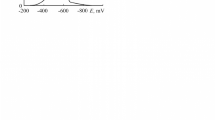Abstract
The oxidation or general corrosion behavior of metals at pressures of 1 atm or more is usually investigated by oxidizing samples under prescribed conditions and then subsequently characterizing the surface produced using one or more of the experimental methods available. This article describes a method which obviates the necessity of transferring samples from the oxidizing environment to the instrument for analysis, is nondestructive, and monitors the oxidizing surface in situ. The oxidation of iron, chromium, and a 9% chromium-iron alloy in carbon dioxide at atmospheric pressure and at 773°K is described. The surfaces of these materials were analyzed by Auger electron spectroscopy during exposure to the gas. Spectra and diagrams illustrating the variation in surface composition as oxidation proceeded are shown and possible mechanisms for the oxidation reactions are briefly discussed. The formation of the surface oxide on iron and on the 9% Cr-Fe alloy appears to follow very similar paths under the conditions of oxidation used. In all the materials studied trace impurities such as sulfur participated in the oxidation reactions.
Similar content being viewed by others
References
C. Tyzack and H. C. Cowen,At. Energy Rev. 14, 263 (1976).
P. Auger,J. Phys., Radium 6, 205 (1925).
C. C. Chang, inCharacterization of Solid Surfaces, P. F. Kane and G. R. Larrabee, eds. (Plenum, New York, 1974), p. 509.
J. A. Bearden and A. F. Burr,Rev. Mod. Phys. 39, 125 (1967).
K. Siegbahn, C. Nordling, A. Fahlman, R. Nordberg, K. Hamrin, J. Hedman, G. Johansson, T. Bergmark, S. E. Karlsson, I. Lindgren, and B. J. Lindberg,ESCA-Atomic, Molecular and Solid-State Structure Studied by Means of Electron Spectroscopy (Almqvist and Wiksell, Uppsala, 1967). (New edition, North-Holland, Amsterdam, in press).
M. Suleman and E. B. Pattinson,Surf. Sci. 35, 75 (1973).
F. J. Szalkowski and G. A. Somorjai,J. Chem. Phys. 56, 6097 (1972).
S. Ekeland and C. Leygraf,Surf. Sci. 40, 179 (1973).
G. C. Allen and R. K. Wild,J. Chem. Soc., Dalton Trans. 493 (1974).
G. C. Allen and R. K. Wild,J. Electron Spectrosc. Relat. Phenom. 5, 409 (1974).
D. T. Quinto and W. D. Robertson,Surf. Sci. 27, 645 (1971).
J. W. Hass and D. J. Pocker,J. Vac. Sci. Technol. 11, 1087 (1974).
D. F. Stein,J. Vac. Sci. Technol. 12, 268 (1975).
D. M. Hercules,Anal. Chem. 48, 3022 (1976).
P. L. Harrison, R. B. Dooley, R. K. Lister, D. B. Meadowcroft, P. J. Nolan, R. E. Pendlebury, P. L. Surman, and M. R. Wootton, inCorrosion of Steels in CO2, D. R. Holmes, R. B. Hill, and L. M. Wyatt, eds. (British Nuclear Energy Society, 1974), p. 220.
P. A. Redhead, J. P. Hobson, and E. V. Kornelson,The Physical Basis of Ultra High Vacuum (Chapman and Hall, London, 1968).
K. Nakayama, M. Ono, and H. Shimizu,J. Vac. Sci. Technol. 9, 749 (1972).
J. P. Coad and J. G. Cunningham,J. Electron Spectrosc. Relat. Phenom. 3, 435 (1974).
G. Betz, G. K. Wehner, L. Toth, and A. Joshi,J. Appl. Phys. 45, 5312 (1974).
M. Seo, J. B. Lumsden, and R. W. Staehle,Surf. Sci. 50, 541 (1975).
M. P. Hooker and J. T. Grant,Surf. Sci. 51, 328 (1975).
R. K. Wild,Vacuum 26, 447 (1976).
R. K. Wild,Corros. Sci. 17, 87 (1977).
R. K. Wild,Corros. Sci. 13, 105 (1973).
R. Hales, A. C. Hill, and R. K. Wild,Corros. Sci. 13, 325 (1973).
L. A. Harris,J. Appl. Phys. 39, 1419 (1968).
J. P. Coad and J. C. Rivière,Proc. Roy. Soc. London, Ser. A 331, 403 (1972).
M. P. Seah and E. D. Hondros,Proc. Roy. Soc. London, Ser. A 335, 191 (1973).
R. E. Weber and A. L. Johnson,J. Appl. Phys. 40, 314 (1969).
G. C. Allen, P. M. Tucker, and R. K. Wild,J.C.S. Faraday, Part II, (submitted for publication).
J. C. P. Garret, S. K. Lister, P. J. Nolan, and J. T. Cook, inCorrosion of Steels in CO2, D. R. Holmes, R. B. Hill, and L. M. Wyatt, eds. (British Nuclear Energy Society, 1974), p. 298.
A. M. Pritchard and A. E. Truswell, inCorrosion of Steels in CO2, D. R. Holmes, R. B. Hill, and L. M. Wyatt, eds. (British Nuclear Energy Society, 1974), p. 234.
J. H. G. Monypenny,Stainless Iron and Steel, Vol. 1 (Chapman and Hall, London, 1951).
C. C. Chang, inCharacterization of Solid Surfaces, P. F. Kane and G. R. Larrabee, eds. (Plenum, New York, 1974), p. 542.
G. C. Allen, I. T. Brown, and R. K. Wild,Met. Sci. J. (submitted for publication).
Author information
Authors and Affiliations
Rights and permissions
About this article
Cite this article
Allen, G.C., Brown, I.T. & Wild, R.K. A new approach to the study of the oxidation of metals in hostile environments. Oxid Met 12, 83–110 (1978). https://doi.org/10.1007/BF00609976
Received:
Issue Date:
DOI: https://doi.org/10.1007/BF00609976




